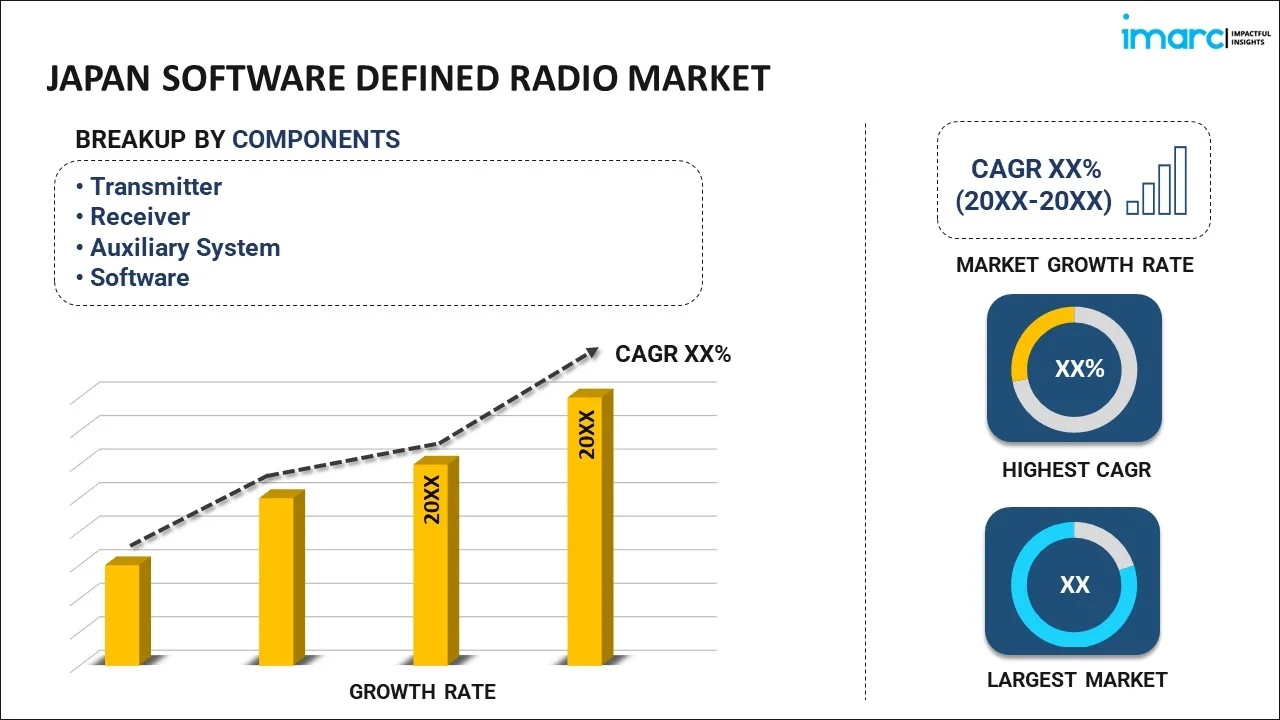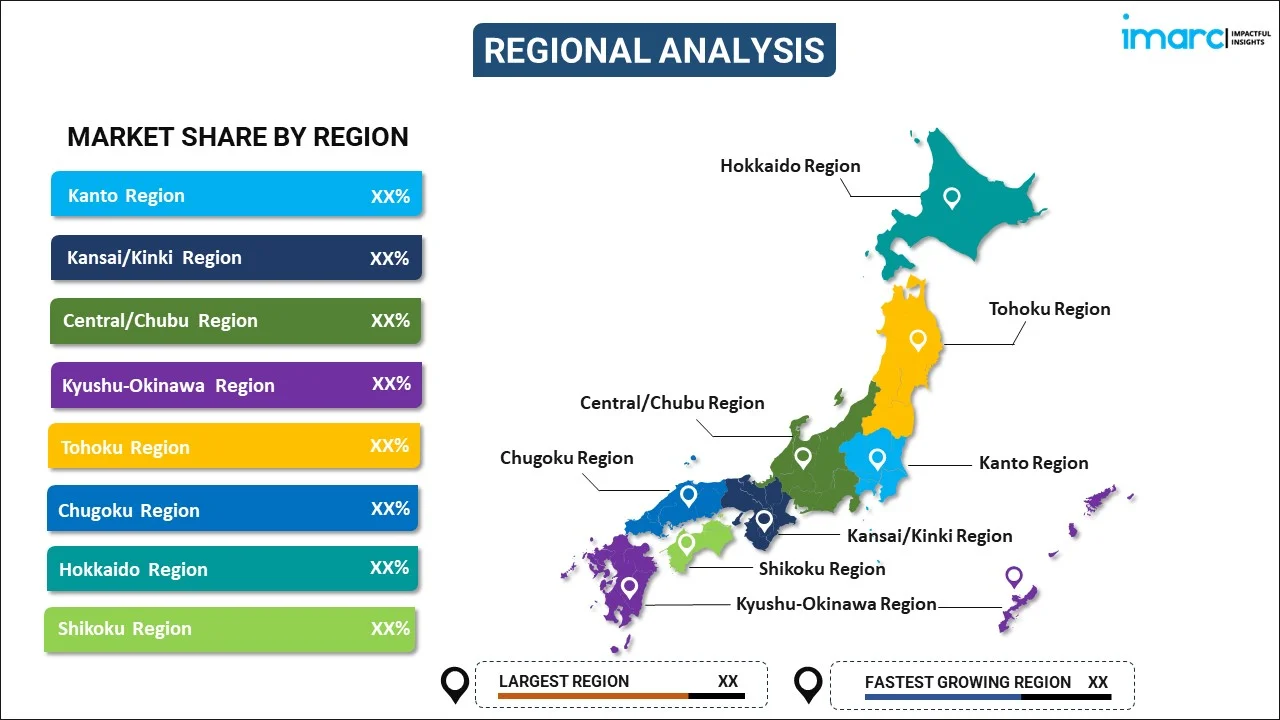
Japan Software Defined Radio Market Report by Component (Transmitter, Receiver, Auxiliary System, Software), Type (Joint Tactical Radio System (JTRS), Cognitive Radio, General Purpose Radio, Terrestrial Trunked Radio (TETRA), and Others), Platform (Land, Airborne, Naval, Space), Frequency Band (High Frequency, Very High Frequency, Ultra-High Frequency, and Others), Application (Aerospace and Defense, Commercial, Telecommunication, and Others), and Region 2025-2033
Market Overview:
Japan software defined radio market size reached USD 1,419.4 Million in 2024. Looking forward, IMARC Group expects the market to reach USD 3,586.3 Million by 2033, exhibiting a growth rate (CAGR) of 10.8% during 2025-2033. The ongoing advancements in wireless communication technologies, such as 5G, which push the need for flexible and adaptable communication systems, are driving the market.
|
Report Attribute
|
Key Statistics
|
|---|---|
|
Base Year
|
2024 |
|
Forecast Years
|
2025-2033
|
|
Historical Years
|
2019-2024
|
| Market Size in 2024 | USD 1,419.4 Million |
| Market Forecast in 2033 | USD 3,586.3 Million |
| Market Growth Rate (2025-2033) | 10.8% |
Software defined radio (SDR) is a revolutionary technology that replaces traditional hardware components in radio systems with software. Unlike conventional radios, which rely on fixed hardware for functions like filtering and modulation, SDR utilizes programmable software to perform these tasks. This flexibility allows for dynamic reconfiguration of radio parameters, enabling versatile signal processing and adapting to various communication standards without the need for physical hardware modifications. SDR platforms typically consist of a general-purpose processor or field-programmable gate array (FPGA) that can be reprogrammed to handle different communication protocols. This adaptability makes SDR valuable in applications ranging from wireless communication and military radios to amateur radio and spectrum monitoring. SDR's ability to evolve and upgrade through software updates makes it a cost-effective and versatile solution in the ever-changing landscape of wireless communication technologies.
Japan Software Defined Radio Market Trends:
The software defined radio market in Japan is experiencing unprecedented growth, fueled by several key drivers that seamlessly interconnect to shape its trajectory. Firstly, the increasing demand for versatile communication systems in both military and commercial sectors is propelling the SDR market forward. This demand stems from the inherent flexibility of SDR, allowing users to adapt to evolving communication standards without the need for costly hardware replacements. Moreover, the growing prevalence of wireless communication and the burgeoning Internet of Things (IoT) ecosystem are synergistically driving the expansion of the SDR market. Additionally, the relentless pursuit of spectrum efficiency and the push towards 5G deployment are intricately linked factors intensifying the demand for SDR solutions. Furthermore, regional initiatives promoting interoperability and the harmonization of communication standards contribute to the SDR market's ascent. In essence, the software defined radio market in Japan is navigating a landscape intricately woven with diverse yet interconnected market drivers, fostering a dynamic environment poised for continued expansion.
Japan Software Defined Radio Market Segmentation:
IMARC Group provides an analysis of the key trends in each segment of the market, along with forecasts at the country level for 2025-2033. Our report has categorized the market based on component, type, platform, frequency band, and application.
Component Insights:

- Transmitter
- Receiver
- Auxiliary System
- Software
The report has provided a detailed breakup and analysis of the market based on the component. This includes transmitter, receiver, auxiliary system, and software.
Type Insights:
- Joint Tactical Radio System (JTRS)
- Cognitive Radio
- General Purpose Radio
- Terrestrial Trunked Radio (TETRA)
- Others
A detailed breakup and analysis of the market based on the type have also been provided in the report. This includes joint tactical radio system (JTRS), cognitive radio, general purpose radio, terrestrial trunked radio (TETRA), and others.
Platform Insights:
- Land
- Airborne
- Naval
- Space
The report has provided a detailed breakup and analysis of the market based on the platform. This includes land, airborne, naval, and space.
Frequency Band Insights:
- High Frequency
- Very High Frequency
- Ultra-High Frequency
- Others
A detailed breakup and analysis of the market based on the frequency band have also been provided in the report. This includes high frequency, very high frequency, ultra-high frequency, and others.
Application Insights:
- Aerospace and Defense
- Commercial
- Telecommunication
- Others
The report has provided a detailed breakup and analysis of the market based on the application. This includes aerospace and defense, commercial, telecommunication, and others.
Regional Insights:

- Kanto Region
- Kansai/Kinki Region
- Central/ Chubu Region
- Kyushu-Okinawa Region
- Tohoku Region
- Chugoku Region
- Hokkaido Region
- Shikoku Region
The report has also provided a comprehensive analysis of all the major regional markets, which include Kanto Region, Kansai/Kinki Region, Central/ Chubu Region, Kyushu-Okinawa Region, Tohoku Region, Chugoku Region, Hokkaido Region, and Shikoku Region.
Competitive Landscape:
The market research report has also provided a comprehensive analysis of the competitive landscape. Competitive analysis such as market structure, key player positioning, top winning strategies, competitive dashboard, and company evaluation quadrant has been covered in the report. Also, detailed profiles of all major companies have been provided.
Japan Software Defined Radio Market Report Coverage:
| Report Features | Details |
|---|---|
| Base Year of the Analysis | 2024 |
| Historical Period | 2019-2024 |
| Forecast Period | 2025-2033 |
| Units | Million USD |
| Scope of the Report | Exploration of Historical Trends and Market Outlook, Industry Catalysts and Challenges, Segment-Wise Historical and Future Market Assessment:
|
| Components Covered | Transmitter, Receiver, Auxiliary System, Software |
| Types Covered | Joint Tactical Radio System (JTRS), Cognitive Radio, General Purpose Radio, Terrestrial Trunked Radio (TETRA), Others |
| Platforms Covered | Land, Airborne, Naval, Space |
| Frequency Bands Covered | High Frequency, Very High Frequency, Ultra-High Frequency, Others |
| Applications Covered | Aerospace and Defense, Commercial, Telecommunication, Others |
| Regions Covered | Kanto Region, Kansai/Kinki Region, Central/ Chubu Region, Kyushu-Okinawa Region, Tohoku Region, Chugoku Region, Hokkaido Region, Shikoku Region |
| Customization Scope | 10% Free Customization |
| Post-Sale Analyst Support | 10-12 Weeks |
| Delivery Format | PDF and Excel through Email (We can also provide the editable version of the report in PPT/Word format on special request) |
Key Questions Answered in This Report:
- How has the Japan software defined radio market performed so far and how will it perform in the coming years?
- What has been the impact of COVID-19 on the Japan software defined radio market?
- What is the breakup of the Japan software defined radio market on the basis of component?
- What is the breakup of the Japan software defined radio market on the basis of type?
- What is the breakup of the Japan software defined radio market on the basis of platform?
- What is the breakup of the Japan software defined radio market on the basis of frequency band?
- What is the breakup of the Japan software defined radio market on the basis of application?
- What are the various stages in the value chain of the Japan software defined radio market?
- What are the key driving factors and challenges in the Japan software defined radio?
- What is the structure of the Japan software defined radio market and who are the key players?
- What is the degree of competition in the Japan software defined radio market?
Key Benefits for Stakeholders:
- IMARC’s industry report offers a comprehensive quantitative analysis of various market segments, historical and current market trends, market forecasts, and dynamics of the Japan software defined radio market from 2019-2033.
- The research report provides the latest information on the market drivers, challenges, and opportunities in the Japan software defined radio market.
- Porter's five forces analysis assist stakeholders in assessing the impact of new entrants, competitive rivalry, supplier power, buyer power, and the threat of substitution. It helps stakeholders to analyze the level of competition within the Japan software defined radio industry and its attractiveness.
- Competitive landscape allows stakeholders to understand their competitive environment and provides an insight into the current positions of key players in the market.
Need more help?
- Speak to our experienced analysts for insights on the current market scenarios.
- Include additional segments and countries to customize the report as per your requirement.
- Gain an unparalleled competitive advantage in your domain by understanding how to utilize the report and positively impacting your operations and revenue.
- For further assistance, please connect with our analysts.
 Inquire Before Buying
Inquire Before Buying
 Speak to an Analyst
Speak to an Analyst
 Request Brochure
Request Brochure
 Request Customization
Request Customization




.webp)




.webp)












